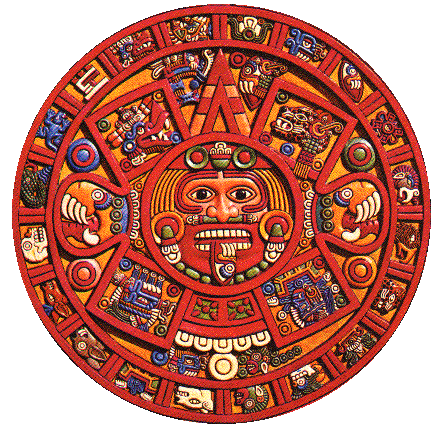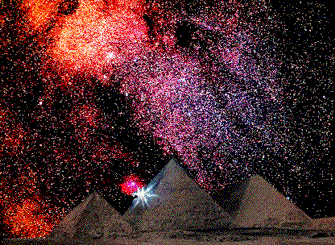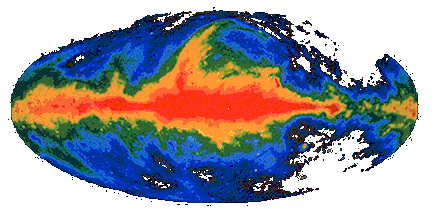 |
 |
 |
The
radio-image from Sagitt A, the center of our
galaxy. Why
Galactic Time? arrangement
of the pyramids at Gizeh to the formation of
Orion. Sagittarius,
the sign the center of our galaxy is
in. In fact
the latter case of present day popular astrology should
be called planetology because the signs one reckons with
are fixed to the tropical year which gives a 'solar'
zodiac
to the seasons and solar month's different from the
astronomical zodiac which does account for the
precession.
Astrology as such therefore doesn't really care about the
stars, nor does it actively observe the constellations
one talks about. In the old days though, from times as
early as the vedic civilization astrology was a high
standing culture of significance in running the affairs
of the state. Culturally
we in fact have set our birthdays to it, but with the
shifting of the tropical year to the celestial sky, the
precession, has one on a lifetime of seventy years died
at the time the celestial sky has shifted for more then a
day. Hence the persistent belief in astrology. Therefore
the
subject of galactic time is solely important for the
collective of the worldculture persisting for longer than
a century.
It transcends the individual interest to the level of the
interest of the collective to keep the same time identity
accounting for the dynamic universe in an illusion-free
scientific manner. This sameness is essential for the
survival and stability of a culture. Because of the
selfawareness of our growing mondial culture and the
wished stability therof is a clear vision of the dynamic
reality that conditions all living creatures thus
important. Therefore this site offers Galactic time ,
the
third option of order,
after the calendaring to the sun and the moon. © The
Order of Time
![]()

![]() Why
Galactic time?
Why
Galactic time?

![]() Of
all the time-phenomena, the precession
of the equinox,
the gradual shift of the stars in the celestial sky, is
culturally the most elusive. It has been cause of a lot
of worries. The Aztec-civilzation,
e.g.
which kept a very scientific respect for the celestial
sky in its time culture, couldn't cope with the
precession which caused the sungod no longer to rise in
the Milky Way. This was a bad omen and would lead to the
downfall of the culture. Shortly after that the Spanish
indeed destroyed their culture colonizing and christening
South America. Whether superstitious or not, fact is that
the culture lost its self-confidence with the dynamic of
the celestial sky. The fact that the South American
Indians on themselves had a keen sense of astronomy,
building pyramids of observation like the Egyptians
coudn't prevent this. The Maya culture even kept a
calendar to the planet Venus (see picture) for religious
purposes,
(see for
links: ancient
and lost civilizations
and
the time-directory:
calendars).
Of
all the time-phenomena, the precession
of the equinox,
the gradual shift of the stars in the celestial sky, is
culturally the most elusive. It has been cause of a lot
of worries. The Aztec-civilzation,
e.g.
which kept a very scientific respect for the celestial
sky in its time culture, couldn't cope with the
precession which caused the sungod no longer to rise in
the Milky Way. This was a bad omen and would lead to the
downfall of the culture. Shortly after that the Spanish
indeed destroyed their culture colonizing and christening
South America. Whether superstitious or not, fact is that
the culture lost its self-confidence with the dynamic of
the celestial sky. The fact that the South American
Indians on themselves had a keen sense of astronomy,
building pyramids of observation like the Egyptians
coudn't prevent this. The Maya culture even kept a
calendar to the planet Venus (see picture) for religious
purposes,
(see for
links: ancient
and lost civilizations
and
the time-directory:
calendars).
![]()
![]()
 In
England,
so
archeologists
agree , was ancient Stonehenge probably erected for
religious purposes. The British astronomer
Gerald
Hawkins
theorized
in
1963 that the arrangement of stones was used as a huge
astronomical instrument. For the sun this is still an
interesting observatory valid as long as our axis of
rotation hasn't shifted significantly relative to the
sun. But for observing the celestial sky, if it ever
served that function, it has lost its value: the stars
ran out of position making the celestial arrangement of
the stones to the celestial sky an arbitrary
one.
In
England,
so
archeologists
agree , was ancient Stonehenge probably erected for
religious purposes. The British astronomer
Gerald
Hawkins
theorized
in
1963 that the arrangement of stones was used as a huge
astronomical instrument. For the sun this is still an
interesting observatory valid as long as our axis of
rotation hasn't shifted significantly relative to the
sun. But for observing the celestial sky, if it ever
served that function, it has lost its value: the stars
ran out of position making the celestial arrangement of
the stones to the celestial sky an arbitrary
one.![]()

![]() In
Egypt
the great pyramids at Gizeh were aligned to the
constellation called Orion, but because of the precession
these pyramids no longer properly function as a celestial
observatory. One needs computers to reconstruct the
celestial sky at the time of their building to find out
they indeed were originally aligned in the direction to
that constellation to which the pyramids had been
arranged among themselves to represent the
sign.(see
also The
Pyramids of Egypt )
In
Egypt
the great pyramids at Gizeh were aligned to the
constellation called Orion, but because of the precession
these pyramids no longer properly function as a celestial
observatory. One needs computers to reconstruct the
celestial sky at the time of their building to find out
they indeed were originally aligned in the direction to
that constellation to which the pyramids had been
arranged among themselves to represent the
sign.(see
also The
Pyramids of Egypt )
![]()
![]() All
great cultures that tried to respect the celestial sky
have failed in doing so because of the precession and
have disappeared. The pyramids in South America and
Egypt, Stonehenge, and even astrology
which claims to be oriented at the stars, have lost their
stature as cultures of significance.
All
great cultures that tried to respect the celestial sky
have failed in doing so because of the precession and
have disappeared. The pyramids in South America and
Egypt, Stonehenge, and even astrology
which claims to be oriented at the stars, have lost their
stature as cultures of significance.
![]()
![]() Because
it is logical (scientific) as well as religious to count
with the stars humanity has tried to maintain cultures to
the stars. They all disappeared in corruption and decay
overtaken by stronger, less illusioned and more stable
cultures. For a culture it
is important though to respect the complete whole of the
universe as it is part of the time of its life and
scientific and religious consciousness.
The
Hindus call the galaxy S'is'umara
(dolphin)
and consider its center the navel of Vishnu, the
Maintainer (see
S.B.
5.23:8
and S.B.
2.2: 25).
It is the third reference after the sun and the moon
telling how one relates to the cosmic where all of
existence is found. Psychologically it settles the final
identity and selfawareness of the planet assigning it a
defined place and defined life among the
stars.
Because
it is logical (scientific) as well as religious to count
with the stars humanity has tried to maintain cultures to
the stars. They all disappeared in corruption and decay
overtaken by stronger, less illusioned and more stable
cultures. For a culture it
is important though to respect the complete whole of the
universe as it is part of the time of its life and
scientific and religious consciousness.
The
Hindus call the galaxy S'is'umara
(dolphin)
and consider its center the navel of Vishnu, the
Maintainer (see
S.B.
5.23:8
and S.B.
2.2: 25).
It is the third reference after the sun and the moon
telling how one relates to the cosmic where all of
existence is found. Psychologically it settles the final
identity and selfawareness of the planet assigning it a
defined place and defined life among the
stars.
Radio image of the celestial sky
showing our galaxy seen from the inside
![]()